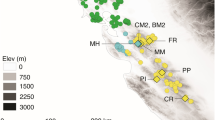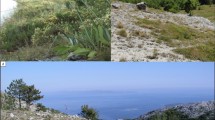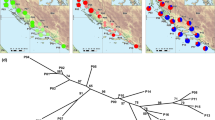Abstract
The mating system of the Hawaiian plant Bidens menziesii subsp. filiformis was examined in four populations, using progeny arrays assayed at four polymorphic allozyme loci. Average selfing rates ranged near 50 per cent in all populations. Evidence that consanguineous (non-self) matings contributed to selling was given by (1) gene frequency variation among subsites in two populations and (2) significant among-plant regressions of outcrossing-pollen gene frequency upon ovule genotype, based upon mating system estimates for individual plants. These estimates for individual plants, whose properties are discussed, showed significant among-plant variation for (1) single-locus selling rates in three populations, (2) multilocus selling rates in two populations, and (3) pollen gene frequency in three populations.
Expected effects of population substructure upon among-plant variation of selling and pollen gene frequency are given in terms of Wright's F statistics and parameters of the “effective selling model”. In three populations, much of the single-locus selling variation was manifested in a tendency for inbred plants to effectively self more than outbred plants. This assortment of selfing, termed “inbreeding assortative selfing”, maintains the spatial variation of Wright's F and is a covariation of gene fixation in parents with genetic similarities between mates. This variation of inbreeding might allow the localised generation and establishment of homozygous genotypes of evolutionary significance.
Similar content being viewed by others
Article PDF
References
Brown, A H D, and Allard, R W. 1970. Estimation of the mating system in open-pollinated maize using isozyme polymorphisms. Genetics, 66, 133–145.
Carlquist, S. 1966. The biota of long-distance dispersal. I. Principles of dispersal and evolution. Quarterly Review of Biology, 41, 247–270.
Clegg, M. 1980. Measuring plant mating systems. Bioscience, 30, 814–818.
Clegg, M, Kahler, A L, and Allard, R W. 1978. Estimation of life cycle components of selection in an experimental plant population. Genetics, 89, 765–792.
Ellstrand, N C, and Foster, K W. 1983. Impact of population structure on the apparent outcrossing rate of grain sorghum (Sorghum bicolor). Theoretical and Applied Genetics, 66, 323–327.
Ennos, R A, and Clegg, M T. 1982. Effect of population substructuring on estimates of outcrossing rate in plant populations. Heredity, 48, 283–292.
Fyfe, J L, and Bailey, N T J. 1951. Plant breeding studies in leguminous forage crops. I. Natural crossbreeding in winter beans. J Agric Sci, 41, 371–378.
Ganders, F R, and Nagata, K M. 1984. The role of hybridization in the evolution of Bidens on the Hawaiian Islands. In Grant, W. F., (ed.) Plant Biosystematics, Don Mills, Ontario, Academic Press, Canada, pp. 179–194.
Hamrick, J L. 1982. Plant population genetics and evolution. American Journal of Botany, 69, 1685–1693.
Helenurm, K. 1983. Genetic differentiation of Hawaiian Bidens. MSc Thesis, University of British Columbia, Vancouver, Canada.
Helenurm, K, and Ganders, F R. 1985. Adaptive radiation and genetic differentiation in Hawaiian Bidens. Evolution, in press.
Nei, M. 1973. Analysis of gene diversity in subdivided populations. Proceedings National Academy of Sciences (USA), 70, 3321–3323.
Ritland, K. 1984. The effective proportion of self-fertilization with consanguinous matings in inbred populations. Genetics, 106, 139–152.
Ritland, K. 1985a. The genetic mating structure of subdivided populations. I. Open mating model. Theoretical Population Biology, 27, 51–74.
Ritland, K. 1985b. Estimation and optimal progeny size for the mixed mating and effective selling models. Biometrics, in press.
Ritland, K, and Jain, S K. 1981. A model for the estimation of outcrossing rate and gene frequencies using n independent loci. Heredity, 47, 35–52.
Ritland, K, and El-Kassaby, Y A. 1985. The nature of inbreeding in a seed orchard of Douglas-fir as shown by an efficient multilocus model. Theoretical and Applied Genetics, in press.
Roose, M, and Gottlieb, L. 1976. Genetic and biochemical consequences of polyploidy in Tragopogon. Evolution, 30, 818–830.
Sanders, T B, and Hamrick, J L. 1979. Variation in the breeding system of Elymus canadensis. Evolution, 34, 117–122.
Schoen, D J, and Clegg, M T. 1984. Estimation of mating system parameters when outcrossing events are correlated. Proceedings National Academy of Sciences (USA), 81, 5258–5262.
Shaw, D V, and Allard, R W. 1981. A multilocus estimator of mating system parameters in plant populations. Proceedings National Academy of Sciences (USA), 78, 1298–1302.
Shaw, D N, and Allard, R W. 1982. Estimation of outcrossing rates in Douglas-fir using isozyme markers. Theoretical and Applied Genetics, 62, 113–120.
Smyth, C A, and Hamrick, J L. 1984. Variation in estimates of outcrossing in musk thistle populations. Journal of Heredity, 75, 303–307.
Wright, S. 1969. Evolution and the Genetics of Populations. Volume II. The Theory of Gene Frequencies. University of Chicago Press, Chicago.
Author information
Authors and Affiliations
Rights and permissions
About this article
Cite this article
Ritland, K., Ganders, F. Variation in the mating system of Bidens menziesii (Asteraceae) in relation to population substructure. Heredity 55, 235–244 (1985). https://doi.org/10.1038/hdy.1985.96
Received:
Issue date:
DOI: https://doi.org/10.1038/hdy.1985.96
This article is cited by
-
Reproductive Biology of Asteraceae on Oceanic Islands
The Botanical Review (2023)
-
A maximum-likelihood estimation of pairwise relatedness for autopolyploids
Heredity (2015)
-
Effect of variation in herkogamy on outcrossing within a population of Gilia achilleifolia
Heredity (2006)
-
Field and experimental evidence of preferential selfing in the freshwater mollusc Lymnaea truncatula (Gastropoda, Pulmonata)
Heredity (2004)
-
Selfing and biparental inbreeding: a mating system analysis in Lymnaea peregra (Gastropoda: Lymnaeidae)
Heredity (1997)



